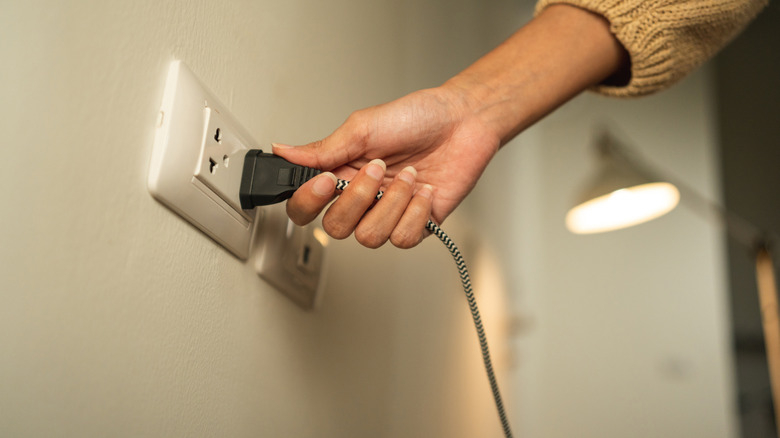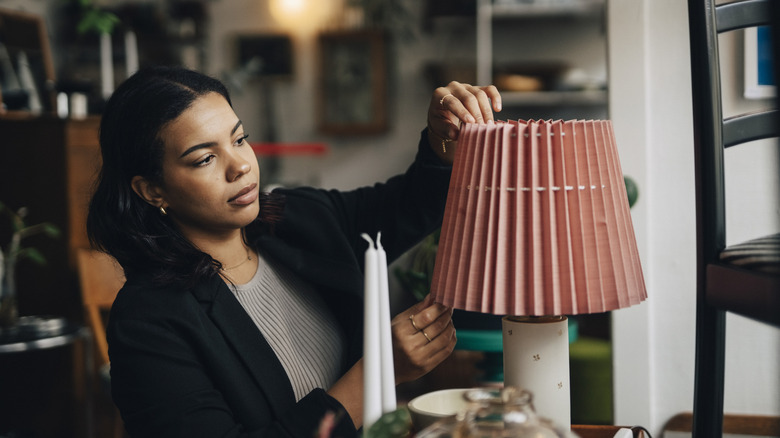The One Question To Ask Before Buying Vintage Lighting
We may receive a commission on purchases made from links.
Vintage lighting fixtures can be a beautiful way to light up your space, especially if your home décor scheme favors an old-world or fun retro vibe. Options for beautifully layered lighting are plentiful –- including lamps, pendant lights, chandeliers, and sconces, many of which may easily be several decades old. You might even find that there are vintage lighting styles that instantly warm up a kitchen, which would work well in your home. While these lamps add a sense of character to your space, there are some things to consider before bringing one into your home. Chief among them are safety and functionality. Thinking about these things before you buy can make a world of difference as to whether you enjoy your lighting piece for many years to come, or if it's a bust. The one question you should ask before buying any vintage light is whether it needs rewiring, as this can be an additional expense to consider.
You can find these lighting pieces at thrift stores, flea markets, estate sales, and other secondhand venues, often for a bargain price compared to similar vintage reproductions from modern retailers. While some may work in their existing state, they often lack many of the safety and grounding regulations put in place today, which can make them a possible shock or fire hazard. In many cases, especially with antique vendors or salvaged lighting shops, you can ask if they will rewire the piece for you (sometimes free, sometimes for an additional cost). There are also other approaches to take if they do not offer this as a service, including a possible DIY approach to rewire the lamp safely and effectively.
What to look for when purchasing vintage lighting
While it can be obvious to figure out if your vintage light works with a flip of the switch, there may be other things you want to look for. A lighting professional will be able to safely diagnose or fix problems you have on site before sale, or recommend another professional who can fix the issue for you. To determine what adjustments need to be made, examine the cord to work out if it's original to the piece or if it has already been replaced at some point. Early 20th century lamps often boast cords that are cotton wrapped and end with two uniform prongs that plug into the outlet. in the latter half of the century, polarized outlets were introduced, which had plugs with one prong slightly larger than the other. However, if the plug has three prongs, the cord was likely produced during the 1960s or after. With the lamp unplugged, pull the cord through your fingers to check for any weakness or wear along the length that may expose internal wires.
You will also want to examine the light socket (where the bulb is inserted) for any discoloration. A blown socket will usually be black, meaning that it needs to be replaced as well. Discoloration or melting on the shade or fixture may indicate that the lamp burns too hot and you may need to use a lower watt bulb with it. Ideally, if you think the wiring or socket need to be replaced, ask the seller if they offer this type of service.
Other ways to get your vintage light working
If you couldn't get your lamp rewired before buying it, you might need to take it to an antique lamp repair store or search for a lighting repair service. Even an antique restoration service should be able to rewire your light for you. You'll just need to factor in the cost, to see whether it's going to be worth it. While rewiring a lamp's existing aged wires is best left to professionals, you also have the option of replacing the inner workings of the lamp entirely. Amazon sells a variety of budget-friendly lamp replacement kits and hardware, like this Lamp Rewire Kit, that have detailed directions on how to swap out the wiring in your lamp. Most kits feature a socket, brass tubing, and a cord that will need to fit through the existing wiring hole. Some may also include hardware for attaching the shade.
If you find a beautiful vintage lamp or fixture, but do not want to pay to have it repaired, or rewire it yourself, you can also buy battery-powered LED bulbs that screw into existing sockets and operate via a remote. Just remove the cord entirely with wire cutters. This also works well for functioning lamps without an outlet nearby. You can even turn vintage wall sconces into battery-operated rental-friendly fixtures wherever you want them. Or, you can repurpose your vintage find for other uses, like adding solar lights to light up your outdoor space.


